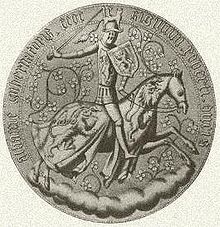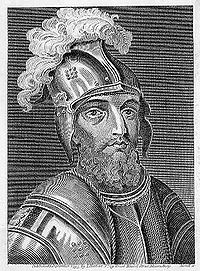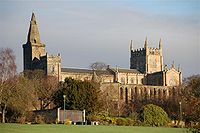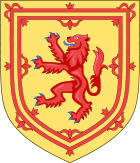- Robert Stewart, Duke of Albany
-
Robert Stewart Governor of Scotland
Duke of Albany, Earl of Fife & Menteith
Reign 1406–1420 (Governor of Scotland) Coronation none Born c. 1340 Died 3 September 1420 Place of death Stirling Castle Predecessor King Robert II Successor Murdoch Stewart, Duke of Albany and Governor of Scotland Consort Margaret, Countess of Menteith (1363–×1380)
Muriella Keith (1380–death)Offspring With Margaret: Murdoch (died 1425)
With Muriella: John Stewart (died 1423)
Andrew (died young)
Robert (died c. 1431)Royal House  (Albany) Stewart
(Albany) StewartFather King Robert II Mother Elizabeth Mure of Rowallan Robert Stewart, Duke of Albany (c. 1340 – 3 September 1420), a member of the Scottish royal house, served as Regent (at least partially) to three different Scottish monarchs (Robert II, Robert III, and James I). He also held the titles of Earl of Menteith (28 February 1361), Earl of Fife (1361; resigned in 1372), Earl of Buchan (1394; resigned in 1406) and Earl of Atholl (1403, for the duration of Robert III's life only), in addition to his 1398 creation as Duke of Albany. A ruthless politician, Albany was widely regarded as having caused the murder of his nephew, the Duke of Rothesay, and brother to the future King James I of Scotland. James was held in captivity in England for eighteen years, during which time Albany served as Regent in Scotland, king in all but name. He died in 1420 and was succeeded by his son, Murdoch Stewart, Duke of Albany, who would be executed for treason when James returned to Scotland in 1425, causing the almost complete ruin of the Albany Stewarts.
Contents
Early life and ancestry
Robert Stewart was an illegitimate son of the future King Robert II of Scotland (1316–1390) and of Elizabeth Mure of Rowallan. He was legitimated in 1349 by his parents' marriage. Robert's grandfather was Walter Stewart, 6th High Steward of Scotland (1293–1326) and his father was the first monarch of the House of Stewart. His great-grandfather was Robert the Bruce (1274–1329), legendary victor of the Battle of Bannockburn.
Robert Stewart was raised in a large family with many siblings. His older brother John Stewart (1337–1406) became Earl of Carrick in 1368, and would later be crowned King of Scotland under the name Robert III.
In 1361 Stewart married Margaret Graham, Countess of Menteith (1334–1380), a wealthy divorcee who took Robert as her fourth husband. His sister-in-law's claim to the Earldoms of Menteith and Fife allowed him to assume those titles, becoming Earl of Menteith and Earl of Fife. In 1362 the couple had a son and heir, Murdoch Stewart, (1362–1425) who would in time inherit his father's titles and estates.
Stewart was responsible for the construction of Doune Castle, which remains largely intact today. When Stewart was created Earl of Menteith, he was granted the lands on which Doune Castle now stands. Building may have started any time after this, and the castle was at least partially complete in 1381, when a charter was sealed here.[1]
Politics and war
 Doune Castle, built by Stewart, still stands today.
Doune Castle, built by Stewart, still stands today.
 Falkland Palace, where Robert Stewart's nephew, the Duke of Rothesay, died in mysterious circumstances.
Falkland Palace, where Robert Stewart's nephew, the Duke of Rothesay, died in mysterious circumstances.
Scottish politics in the late 14th century was unstable and bloody, and much of Albany's career would be spent acquiring territory, land and titles, often by violent means.[2] In 1389 his son Murdoch Stewart was appointed Justiciar of Scotland North of the Forth, and father and son would now work together to expand their family interest, bringing them into violent confrontation with other members of the nobility such as Donald McDonald, 2nd Lord of the Isles.[2]
During the reign of their infirm father as King Robert II (1371–1390), Robert Stewart and his older brother Lord Carrick functioned as Regents of Scotland, Kings in all but name, with Albany serving as High Chamberlain of Scotland. He also led several military expeditions and raids into the Kingdom of England.
In 1389, the Earl of Carrick became incapacitated in an accident and, though he nevertheless acceded to the throne as King Robert III in 1390, this "sickness of the body" caused control of the kingdom eventually to devolve in 1399 to his son and heir apparent, David Stewart, Duke of Rothesay, who held the first dukedom created in the Scottish Peerage. Although In 1398 Robert was himself appointed Duke of Albany, bringing him still greater power and wealth, power had begun to shift away from Albany and towards his nephew.
Murder of the Duke of Rothesay
However, the English soon invaded Scotland, and serious differences emerged between Albany and Rothesay. In 1401, Rothesay was accused of unjustifiably appropriating sums from the customs of the burghs on the east coast and confiscating the revenues of the temporalities of the vacant bishopric of St Andrews.[3] Rothesay had also in conjunction with his uncle, Alexander Stewart, Earl of Buchan, confronted Albany's influence in central Scotland—as soon his lieutenancy expired in 1402 Albany acted swiftly and ruthlessly. Rothesay was arrested and imprisoned in Albany's Falkland Castle where he died in March 1402.[4] Rothesay's death probably lay with Albany and Douglas who would have looked upon the possibility of the young prince acceding to the throne with great apprehension. Albany certainly fell under suspicion but he was cleared of all blame by a general council, which found that 'by divine providence and not otherwise, it is discerned that he [Duke Rothesay] departed from this life.' [5][6]
However, even though Albany was exonerated from blame, suspicions of foul play persisted, suspicions which never left Rothesay's younger brother the future James I of Scotland, and which would eventually lead to the downfall of the Albany Stewarts. John Debrett, writing in 1805, was in no doubt of Duke Robert's motives and guilt:
- "This Robert, Duke of Albany, having obtained the entire government from his brother, King Robert, he caused the Duke of Rothesay to be murdered, thinking to bring the Crown into his own family".[7]
After Rothesay's death, the King began to fear for his second son James, who fled Scotland for his own safety. Debrett continues:
- "to avoid the like fate, King Robert resolved to send his younger son James, to France, then about nine years old, who being sea-sick, and forced to land on the English coast...was detained a captive in England eighteen years. At these misfortunes King Robert died of grief in 1406."[7]
Regent of Scotland
 Site of the Battle of Harlaw, where in 1411 Donald McDonald, 2nd Lord of the Isles fought the Stewarts to a bloody standstill.
Site of the Battle of Harlaw, where in 1411 Donald McDonald, 2nd Lord of the Isles fought the Stewarts to a bloody standstill.
After the death of his brother King Robert III, Albany ruled Scotland as Regent, king in all but name. His young nephew, the future James I of Scotland, would remain in exile and imprisonment in England for 18 years. Perhaps unsurprisingly Albany made little effort to secure the young Prince's ransom and return to Scotland, focusing his energies instead on securing his own power and interest.
Albany's political triumph did not settle his differences with the other members of the nobility, in particular Donald McDonald, 2nd Lord of the Isles, who in 1411 led an army of clansmen from the Western Highlands into open battle with the Stewarts. This conflict began when Albany had attempted to secure the Earldom of Ross for his second son John, despite McDonald's better claim.[8] At the Battle of Harlaw (known as "Red Harlaw" on account of its savagery) [9] on 24 July 1411, losses were heavy on both sides, though McDonald's eventual withdrawal allowed the Stewarts to claim a strategic victory.[10] The Stewart army was led by Albany's nephew, Alexander Stewart, Earl of Mar, who would later sit on the jury of knights and peers which convicted Albany's son Murdoch Stewart, Duke of Albany and two of his sons of treason, virtually annihilating the Albany Stewarts.
Marriage and family
 Stewart's son, John Stewart, 2nd Earl of Buchan, in a late 18th century engraving. Buchan was killed at the Battle of Verneuil in 1424.
Stewart's son, John Stewart, 2nd Earl of Buchan, in a late 18th century engraving. Buchan was killed at the Battle of Verneuil in 1424.
Albany married twice. Firstly, in 1361, he married Margaret Graham, Countess of Menteith, (1334–1380) a wealthy divorcee who took him as her fourth husband. His sister-in-law's claim to the Earldoms of Menteith and Fife allowed him to assume those titles after marriage. The couple had eight children, seven daughters and a son:
- Janet Stewart (married Sir David de Moubray)
- Mary Stewart (married Sir William Abernathy, 6th of Saltoun)
- Margaret Stewart (married to Sir John Swinton, 14th of that Ilk)
- Joan Stewart (married Sir Robert Stewart, Lord of Lorn)
- Beatrice Stewart (married Sir James Douglas of Balveny)
- Isabella (Isobel) Stewart (married to Alexander Leslie, 7th Earl of Ross and later to Walter de Haliburton, 1st Lord Haliburton of Dirleton)
- Lady Marjorie Stewart (married to Sir Duncan Campbell, 1st Lord Campbell)
- Murdoch Stewart, Duke of Albany (1362–1425) (Married Joan Douglas and later to Isabel, Countess of Lennox).
Margaret died in 1380 and Albany subsequently married Muriella de Keith, with whom he had four children, the elder of whom was John Stewart, 2nd Earl of Buchan (1381–1424). Buchan fought in France against the English during the Hundred Years War, serving with distinction, but was killed at the Battle of Verneuil on 17 August 1424.
Death and legacy
Albany's son, Murdoch Stewart, Duke of Albany.
The Duke of Albany died in 1420 in Stirling Castle and lies buried in Dunfermline Abbey in Fife. He was succeeded as Duke of Albany and Regent of Scotland by his son, Murdoch Stewart, Duke of Albany. But Murdoch would not enjoy his power for long. In 1425 the exiled King James, captive in England for 18 years, finally returned to Scotland, and executed Murdoch and most of his family for treason, causing the almost complete ruin of the Albany Stewarts.[2][11]
Murdoch Stewart's sole surviving male heir was his youngest son, James the Fat, who fled to Ireland after a brief rebellion against the King over the arrest of his father and brothers. James remained in Ireland, unable to return, and died there in 1429. He was never able to inherit his father's titles, since they had been declared forfeit.
Albany's great-grandson, James "Beg" Stewart, (c. 1410-1470) would eventually secure a pardon from the King and return to Scotland, though the family would never recover their lost estates. James "Beg" Stewart is the ancestor of the Stewarts of Ardvorlich on Lochearnside, whose family history is recounted by Sir Walter Scott in A Legend of Montrose.[12]
Albany in fiction
Nigel Tranter's Stewart Trilogy covers the period when Albany was an important figure in Scotland.
See also
- Scottish monarchs family tree
References
- Debrett, John, p.233, The peerage of England, Scotland, and Ireland, London (1805) Retrieved November 2010
- Mackie, J. D., A History of Scotland, Penguin Books, London (1964).
- McAndrew, Bruce A., Scotland's Historic Heraldry Retrieved November 2010
- Roberts, John L., p.16, Feuds, Forays and Febellions: History of the Highland Clans 1475-1625 Retrieved November 2010
Notes
- ^ Fawcett, Richard (1994). Scottish Architecture from the accession of the Stuarts to the Reformation, 1371–1560. Architectural History of Scotland. Edinburgh University Press. ISBN 0748604650.
- ^ a b c Roberts, John L., p.16, Feuds, Forays and Febellions: History of the Highland Clans 1475-1625 Retrieved November 2010
- ^ Boardman, David Stewart, duke of Rothesay, ODNB
- ^ Grant in Jones et al., The New Cambridge Medieval History, p. 362
- ^ Barrell, Medieval Scotland. p. 149
- ^ Records of the Parliaments of Scotland to 1707, 14 may, 1402, Edinburgh. http://www.rps.ac.uk/
- ^ a b Debrett, John, p.233, The peerage of England, Scotland, and Ireland, London (1805) Retrieved November 2010
- ^ Mackie, p.96
- ^ Mackie, p.97
- ^ Skene, William Forbes (1837), The Highlanders of Scotland: Their Origin, History, and Antiquities, J. Murray, pp. 73–4, http://books.google.com/?id=xIULAAAAYAAJ&pg=RA1-PA74
- ^ McAndrew, Bruce A., p.5, Scotland's Historic Heraldry Retrieved November 2010
- ^ *James Beag Stewart at Stewarts of Balquhidder webpage Retrieved November 2010
Scottish royalty Preceded by
James I of ScotlandHeir of Scotland
as heir presumptive
4 April 1406 – 3 September 1420Succeeded by
Murdoch Stewart, Duke of AlbanyNew creation Duke of Albany
1398–1420Succeeded by
Murdoch StewartPreceded by
Isabel MacduffEarl of Fife
1371–1420Robert Stewart (1398–1420) · Murdoch Stewart (1420–1425) · Alexander Stewart (c. 1458–1485) · John Stewart (1485–1536) · Arthur Stewart (1541) · Lord Darnley (1565–1567) · James VI (1567) · Charles I (1603–1625) · James VII (1660–1685) · Prince Leopold (1881–1884) · Prince Charles Edward (1884–1919)
[Known] Mormaers/Earls of Menteith line (to 1425)
Gille Críst · Muireadhach I · Muireadhach II · Isabella with Walter Comyn · Mary I with Walter Bailloch Stewart · Alexander · Alan · Muireadhach III · Mary II with John de Graham · Margaret with Robert Stewart · Muireadhach IVGraham Earls (1427-1694)
Malise Graham · Alexander Graham · William Graham · John Graham · William Graham · John Graham · William Graham · William GrahamCausantín · Gille Míchéil · Donnchadh I · Donnchadh II · Máel Coluim I · Máel Coluim II · Colbán · Donnchadh III · Donnchadh IV · Isabella · Robert Stewart · Murdoch Stewart
Mormaers or Earls of Atholl [Known] 10th-century mormaers [Known] Mormaers from the Atholl line Máel Muire of Atholl · Matad of Atholl · Máel Coluim of Atholl · Henry of Atholl · Isabella of Atholl (with 1. Tomás Mac Uchtraigh; 2. Alan Durward) · Padraig of Atholl · Forbhlaith of Atholl (with David de Hastings) · Ada de Hastings (with John of Strathbogie) · David I of Strathbogie · John of Strathbogie · David II of StrathbogieAppointed between Robert I and James I John Campbell · William Douglas, Lord of Liddesdale · Robert Stewart · David Stewart, Duke of Rothesay · Robert Stewart, Duke of Albany · Walter StewartStewart of Balveny John Stewart, 1st Earl · John Stewart, 2nd Earl · John Stewart, 3rd Earl · John Stewart, 4th Earl · John Stewart, 5th EarlStewart of Innermeath John Stewart, 1st Earl · James Stewart, 2nd EarlHouse of Stewart Robert II John, Earl of Carrick (later King Robert III) | Walter, Lord of Fife | Robert, Duke of Albany | Alexander, Earl of Buchan | David, Earl of Strathearn | Walter, Earl of AthollRobert III James I James II James III James IV James V Mary I James VI Charles I James VII Mary II (none)Anne Categories:- Regents of Scotland
- Dukes in the Peerage of Scotland
- Dukes of Albany
- Scottish princes
- House of Stuart
- Medieval Gaels
- Earls or mormaers of Fife
- 1340 births
- 1420 deaths
- Burials at Dunfermline Abbey
- Heirs to the Scottish throne
Wikimedia Foundation. 2010.




